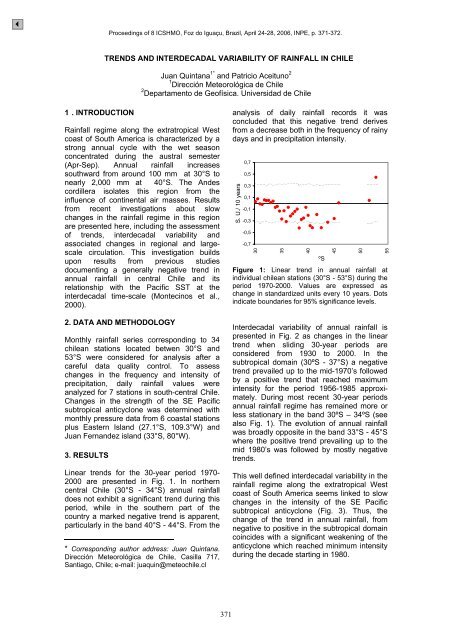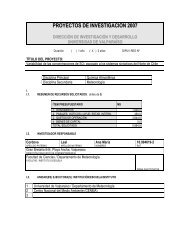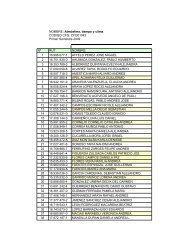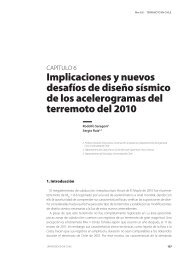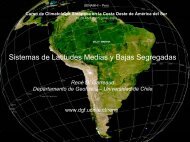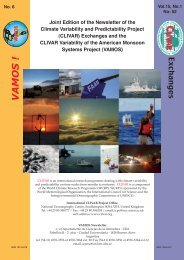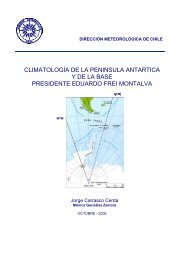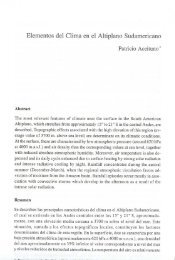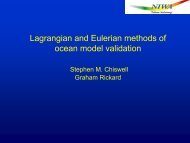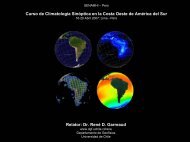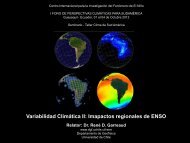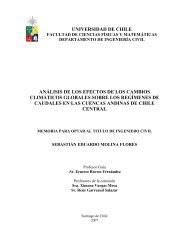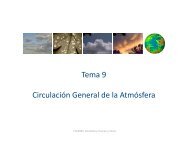trends and interdecadal variability of rainfall in chile - Departamento ...
trends and interdecadal variability of rainfall in chile - Departamento ...
trends and interdecadal variability of rainfall in chile - Departamento ...
Create successful ePaper yourself
Turn your PDF publications into a flip-book with our unique Google optimized e-Paper software.
TRENDS AND INTERDECADAL VARIABILITY OF RAINFALL IN CHILE<br />
Juan Qu<strong>in</strong>tana 1* <strong>and</strong> Patricio Aceituno 2<br />
1 Dirección Meteorológica de Chile<br />
2 <strong>Departamento</strong> de Ge<strong>of</strong>ísica. Universidad de Chile<br />
1 1 . INTRODUCTION<br />
Ra<strong>in</strong>fall regime along the extratropical West<br />
coast <strong>of</strong> South America is characterized by a<br />
strong annual cycle with the wet season<br />
concentrated dur<strong>in</strong>g the austral semester<br />
(Apr-Sep). Annual <strong>ra<strong>in</strong>fall</strong> <strong>in</strong>creases<br />
southward from around 100 mm at 30°S to<br />
nearly 2,000 mm at 40°S. The Andes<br />
cordillera isolates this region from the<br />
<strong>in</strong>fluence <strong>of</strong> cont<strong>in</strong>ental air masses. Results<br />
from recent <strong>in</strong>vestigations about slow<br />
changes <strong>in</strong> the <strong>ra<strong>in</strong>fall</strong> regime <strong>in</strong> this region<br />
are presented here, <strong>in</strong>clud<strong>in</strong>g the assessment<br />
<strong>of</strong> <strong>trends</strong>, <strong><strong>in</strong>terdecadal</strong> <strong>variability</strong> <strong>and</strong><br />
associated changes <strong>in</strong> regional <strong>and</strong> largescale<br />
circulation. This <strong>in</strong>vestigation builds<br />
upon results from previous studies<br />
document<strong>in</strong>g a generally negative trend <strong>in</strong><br />
annual <strong>ra<strong>in</strong>fall</strong> <strong>in</strong> central Chile <strong>and</strong> its<br />
relationship with the Pacific SST at the<br />
<strong><strong>in</strong>terdecadal</strong> time-scale (Montec<strong>in</strong>os et al.,<br />
2000).<br />
2. DATA AND METHODOLOGY<br />
Monthly <strong>ra<strong>in</strong>fall</strong> series correspond<strong>in</strong>g to 34<br />
<strong>chile</strong>an stations located betwen 30°S <strong>and</strong><br />
53°S were considered for analysis after a<br />
careful data quality control. To assess<br />
changes <strong>in</strong> the frequency <strong>and</strong> <strong>in</strong>tensity <strong>of</strong><br />
precipitation, daily <strong>ra<strong>in</strong>fall</strong> values were<br />
analyzed for 7 stations <strong>in</strong> south-central Chile.<br />
Changes <strong>in</strong> the strength <strong>of</strong> the SE Pacific<br />
subtropical anticyclone was determ<strong>in</strong>ed with<br />
monthly pressure data from 6 coastal stations<br />
plus Eastern Isl<strong>and</strong> (27.1°S, 109.3°W) <strong>and</strong><br />
Juan Fern<strong>and</strong>ez isl<strong>and</strong> (33°S, 80°W).<br />
3. RESULTS<br />
L<strong>in</strong>ear <strong>trends</strong> for the 30-year period 1970-<br />
2000 are presented <strong>in</strong> Fig. 1. In northern<br />
central Chile (30°S - 34°S) annual <strong>ra<strong>in</strong>fall</strong><br />
does not exhibit a significant trend dur<strong>in</strong>g this<br />
period, while <strong>in</strong> the southern part <strong>of</strong> the<br />
country a marked negative trend is apparent,<br />
particularly <strong>in</strong> the b<strong>and</strong> 40°S - 44°S. From the<br />
* Correspond<strong>in</strong>g author address: Juan Qu<strong>in</strong>tana.<br />
Dirección Meteorológica de Chile, Casilla 717,<br />
Santiago, Chile; e-mail: juaqu<strong>in</strong>@meteo<strong>chile</strong>.cl<br />
analysis <strong>of</strong> daily <strong>ra<strong>in</strong>fall</strong> records it was<br />
concluded that this negative trend derives<br />
from a decrease both <strong>in</strong> the frequency <strong>of</strong> ra<strong>in</strong>y<br />
days <strong>and</strong> <strong>in</strong> precipitation <strong>in</strong>tensity.<br />
S. U./ 10 years<br />
0,7<br />
0,5<br />
0,3<br />
0,1<br />
-0,1<br />
-0,3<br />
-0,5<br />
-0,7<br />
30<br />
35<br />
40<br />
Figure 1: L<strong>in</strong>ear trend <strong>in</strong> annual <strong>ra<strong>in</strong>fall</strong> at<br />
<strong>in</strong>dividual <strong>chile</strong>an stations (30°S - 53°S) dur<strong>in</strong>g the<br />
period 1970-2000. Values are expressed as<br />
change <strong>in</strong> st<strong>and</strong>ardized units every 10 years. Dots<br />
<strong>in</strong>dicate boundaries for 95% significance levels.<br />
Interdecadal <strong>variability</strong> <strong>of</strong> annual <strong>ra<strong>in</strong>fall</strong> is<br />
presented <strong>in</strong> Fig. 2 as changes <strong>in</strong> the l<strong>in</strong>ear<br />
trend when slid<strong>in</strong>g 30-year periods are<br />
considered from 1930 to 2000. In the<br />
subtropical doma<strong>in</strong> (30ºS - 37°S) a negative<br />
trend prevailed up to the mid-1970’s followed<br />
by a positive trend that reached maximum<br />
<strong>in</strong>tensity for the period 1956-1985 approximately.<br />
Dur<strong>in</strong>g most recent 30-year periods<br />
annual <strong>ra<strong>in</strong>fall</strong> regime has rema<strong>in</strong>ed more or<br />
less stationary <strong>in</strong> the b<strong>and</strong> 30ºS – 34ºS (see<br />
also Fig. 1). The evolution <strong>of</strong> annual <strong>ra<strong>in</strong>fall</strong><br />
was broadly opposite <strong>in</strong> the b<strong>and</strong> 33°S - 45°S<br />
where the positive trend prevail<strong>in</strong>g up to the<br />
mid 1980’s was followed by mostly negative<br />
<strong>trends</strong>.<br />
This well def<strong>in</strong>ed <strong><strong>in</strong>terdecadal</strong> <strong>variability</strong> <strong>in</strong> the<br />
<strong>ra<strong>in</strong>fall</strong> regime along the extratropical West<br />
coast <strong>of</strong> South America seems l<strong>in</strong>ked to slow<br />
changes <strong>in</strong> the <strong>in</strong>tensity <strong>of</strong> the SE Pacific<br />
subtropical anticyclone (Fig. 3). Thus, the<br />
change <strong>of</strong> the trend <strong>in</strong> annual <strong>ra<strong>in</strong>fall</strong>, from<br />
negative to positive <strong>in</strong> the subtropical doma<strong>in</strong><br />
co<strong>in</strong>cides with a significant weaken<strong>in</strong>g <strong>of</strong> the<br />
anticyclone which reached m<strong>in</strong>imum <strong>in</strong>tensity<br />
dur<strong>in</strong>g the decade start<strong>in</strong>g <strong>in</strong> 1980.<br />
ºS<br />
45<br />
50<br />
55<br />
371
Decadal Oscillation. The annular mode at<br />
high latitudes <strong>in</strong> the Southern Hemisphere<br />
may also play a role, but this aspect needs<br />
further <strong>in</strong>vestigation. The significant decrease<br />
<strong>in</strong> <strong>ra<strong>in</strong>fall</strong> <strong>in</strong> south-central Chile dur<strong>in</strong>g recent<br />
decades is a matter <strong>of</strong> concern consider<strong>in</strong>g<br />
that most projections from global <strong>and</strong> regional<br />
climate models <strong>in</strong>dicate a dry<strong>in</strong>g trend for this<br />
region dur<strong>in</strong>g the XXI century.<br />
0,6<br />
0,4<br />
0,2<br />
0,0<br />
-0,2<br />
Figure 2: L<strong>in</strong>ear trend <strong>in</strong> annual <strong>ra<strong>in</strong>fall</strong> (mm/30<br />
years) calculated for latitud<strong>in</strong>al <strong>ra<strong>in</strong>fall</strong> <strong>in</strong>dices <strong>in</strong><br />
Chile, consider<strong>in</strong>g slid<strong>in</strong>g 30-year periods dur<strong>in</strong>g<br />
1930 – 2000. Note that the latitude scale is not<br />
regular.<br />
The marked strengthen<strong>in</strong>g <strong>of</strong> the anticyclone<br />
<strong>in</strong> most recent years (Fig. 3) is consistent with<br />
the concomitant weaken<strong>in</strong>g <strong>of</strong> the positive<br />
trend <strong>in</strong> <strong>ra<strong>in</strong>fall</strong> along the subtropical doma<strong>in</strong><br />
(Fig. 2). Furthermore, the N-S dipolar<br />
structure <strong>in</strong> the <strong>ra<strong>in</strong>fall</strong> trend pattern could be<br />
expla<strong>in</strong>ed by latitud<strong>in</strong>al changes <strong>in</strong> the storm<br />
track over the SE Pacific associated with<br />
changes <strong>in</strong> the <strong>in</strong>tensity <strong>of</strong> the subtropical<br />
anticyclone.<br />
Interdecadal <strong>variability</strong> <strong>of</strong> the SE Pacific<br />
subtropical anticyclone shown <strong>in</strong> Fig. 3 seems<br />
related to large scale changes <strong>in</strong> the Pacific<br />
bas<strong>in</strong> described by the Pacific Decadal<br />
Oscillation (Power et al., 1999). Thus, the<br />
notorious change <strong>in</strong> the phase <strong>of</strong> this<br />
oscillation <strong>in</strong> the mid-1970’s, also revealed <strong>in</strong><br />
the function<strong>in</strong>g <strong>of</strong> the Southern Oscillation, is<br />
at the orig<strong>in</strong> <strong>of</strong> the weaken<strong>in</strong>g <strong>of</strong> the<br />
subtropical anticyclone dur<strong>in</strong>g the 1980’s <strong>and</strong><br />
early 1990’s. Regard<strong>in</strong>g the evolution <strong>of</strong><br />
<strong>ra<strong>in</strong>fall</strong> <strong>in</strong> southern Chile the changes <strong>in</strong> the<br />
function<strong>in</strong>g <strong>of</strong> high latitude phenomena such<br />
as the Southern Hemisphere annular mode<br />
are also relevant as described <strong>in</strong> Qu<strong>in</strong>tana<br />
(2003).<br />
4.- CONCLUDING REMARKS<br />
The <strong><strong>in</strong>terdecadal</strong> <strong>ra<strong>in</strong>fall</strong> <strong>variability</strong> along the<br />
extratropical West coast <strong>of</strong> South America is<br />
related to regional <strong>and</strong> large scale changes <strong>in</strong><br />
the atmospheric circulation, <strong>in</strong>clud<strong>in</strong>g<br />
changes <strong>in</strong> the <strong>in</strong>tensity <strong>of</strong> the SE Pacific<br />
subtropical anticyclone <strong>and</strong> the Pacific<br />
-0,4<br />
-0,6<br />
-0,8<br />
1940<br />
1945<br />
1950<br />
1955<br />
1960<br />
1965<br />
1970<br />
1975<br />
1980<br />
1985<br />
1990<br />
1995<br />
2000<br />
Figure 3: 10-year mov<strong>in</strong>g average <strong>of</strong> the <strong>in</strong>tensity<br />
<strong>of</strong> the SE Pacific subtropical anticyclone calculated<br />
from monthly pressure at 8 stations <strong>in</strong> northern <strong>and</strong><br />
central Chile plus Eastern Isl<strong>and</strong> (27.1°S,<br />
109.3°W) <strong>and</strong> Juan Fern<strong>and</strong>ez isl<strong>and</strong> (33°S, 80°W)<br />
dur<strong>in</strong>g 1970-2002 (thick l<strong>in</strong>e) <strong>and</strong> from monthly<br />
pressure at Santiago (33.5°S, 70.7°W) dur<strong>in</strong>g<br />
1930-2002 (th<strong>in</strong> l<strong>in</strong>e).<br />
5. ACKNOWLEDGMENTS<br />
This study was partially supported by<br />
Fondecyt - Chile through grant 1010570.<br />
Ra<strong>in</strong>fall <strong>and</strong> pressure data was provided by<br />
the Chilean Weather Service.<br />
6. REFERENCES<br />
Montec<strong>in</strong>os, A., R. Garreaud, <strong>and</strong> P.<br />
Aceituno, 2000. Interdecadal <strong>ra<strong>in</strong>fall</strong> <strong>variability</strong><br />
<strong>in</strong> subtropical South America <strong>and</strong> its<br />
relationship with tropical Pacific SST. pp. 66-<br />
67 <strong>in</strong> Prepr<strong>in</strong>ts 6th Int. Conf. S. Hemisphere<br />
Meteorology <strong>and</strong> Oceanography, Santiago-<br />
Chile. AMS<br />
Power S, T. Casey, C. Foll<strong>and</strong>, A. Colman y<br />
V. Mehta, 1999: Inter-decadal Modulation <strong>of</strong><br />
the impact <strong>of</strong> ENSO on Australia. Clim. Dyn.<br />
15: 319-324.<br />
Qu<strong>in</strong>tana, J., 2003: On the mechanisms<br />
expla<strong>in</strong><strong>in</strong>g <strong><strong>in</strong>terdecadal</strong> <strong>ra<strong>in</strong>fall</strong> <strong>variability</strong> <strong>in</strong><br />
Chile. M.Sc. Thesis. Universidad de Chile, 93<br />
pp (<strong>in</strong> spanish).<br />
372


